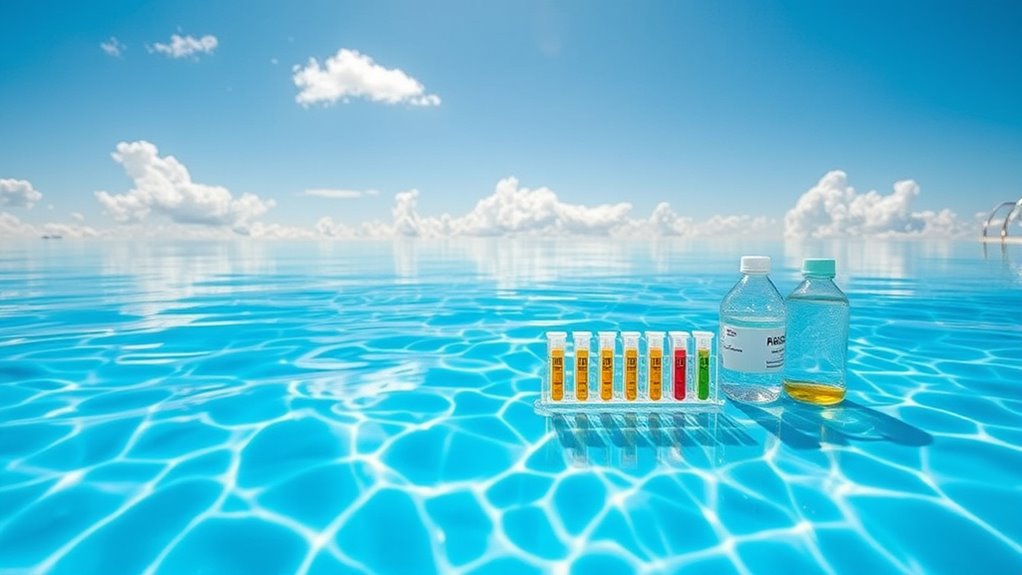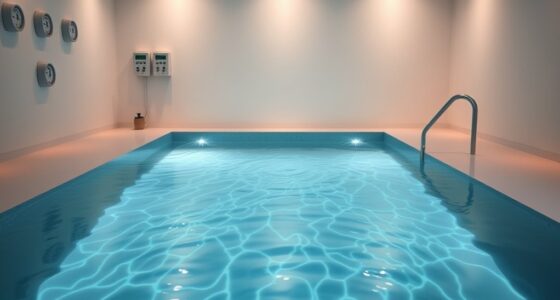To keep your endless pool crystal clear, focus on balancing the essential chemicals like chlorine, pH, and alkalinity. Test your water 2-3 times a week using simple test kits, then adjust chemicals as needed. Maintain proper levels of sanitizer and keep pH between 7.2 and 7.6 to prevent cloudiness and algae. Regularly managing calcium hardness and troubleshooting common issues will guarantee your pool stays inviting and sparkling — learn more to master it all.
Key Takeaways
- Regularly test and maintain chlorine levels between 1-3 ppm to ensure water disinfection and prevent algae growth.
- Keep pH balanced between 7.2 and 7.6 for optimal clarity and swimmer comfort.
- Monitor alkalinity (80-120 ppm) to stabilize pH and prevent sudden fluctuations.
- Maintain calcium hardness around 150-250 ppm to avoid scaling or corrosion.
- Conduct routine cleaning, shocking, and filtration to keep water sparkling and free of contaminants.
Understanding Pool Water Chemistry Basics
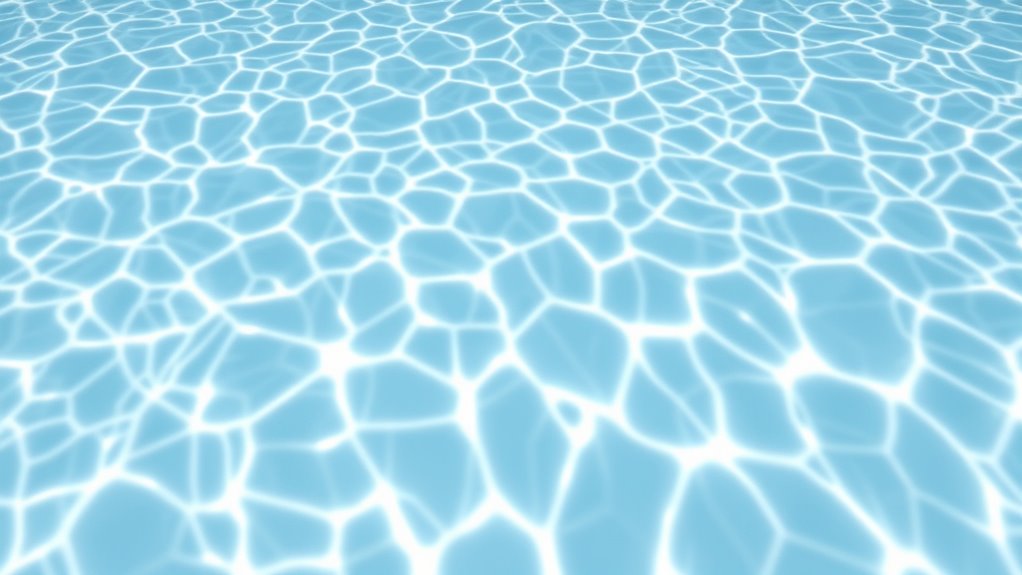
Understanding pool water chemistry basics is essential for keeping your pool safe and inviting. When you grasp how water interacts with chemicals, you’ll better maintain a clean, balanced environment. The main goal is to keep water safe for swimmers by controlling pH levels, chlorine, alkalinity, and other factors. pH measures how acidic or alkaline your water is; ideally, it should stay between 7.2 and 7.6. Chlorine disinfects and kills bacteria, so maintaining proper chlorine levels is vital. Total alkalinity buffers pH changes, preventing sudden shifts. Regular testing with simple kits helps you monitor these levels. When you understand these basics, you can make quick adjustments, avoid cloudy water, and reduce the risk of algae or bacteria growth. Proper chemistry keeps your pool safe, clear, and ready for enjoyment anytime. Being aware of Pinball Machine Weights can also help if you plan to install or move your equipment securely.
The Key Chemicals Every Beginner Should Know
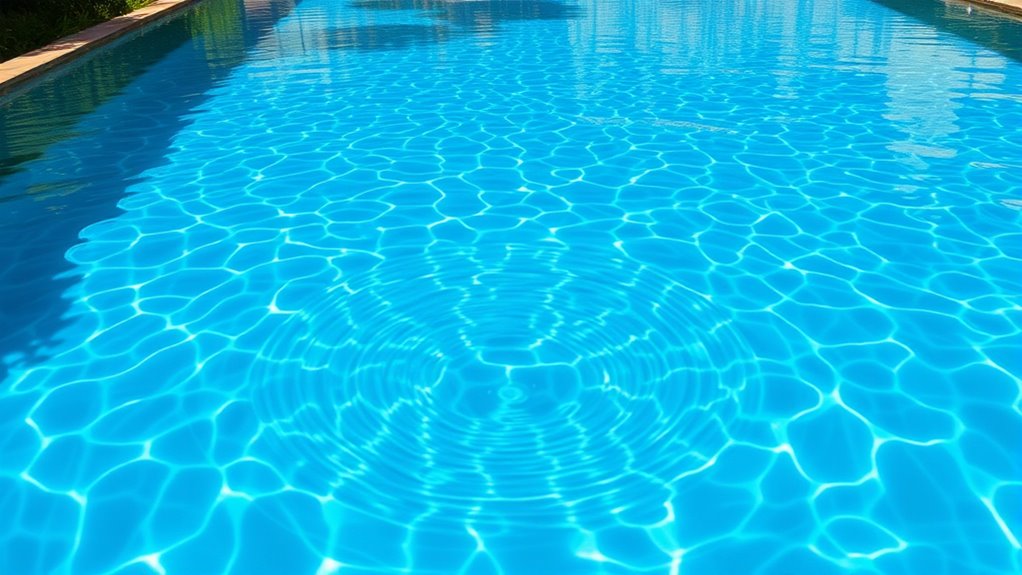
Chlorine is essential for keeping your pool safe and clear by disinfecting the water. It also helps maintain the right pH balance and prevents algae growth. Understanding how to use chlorine effectively is key to keeping your endless pool in top condition. Additionally, proper chemical balance is crucial for preventing corrosion and ensuring the longevity of your pool equipment.
Chlorine’s Role in Disinfection
Have you ever wondered how pools stay clean and safe for swimming? The answer is chlorine. It’s a powerful disinfectant that kills bacteria, viruses, and algae, preventing harmful germs from spreading. When you add chlorine to your pool, it forms compounds called chloramines that attack and destroy contaminants. This process keeps the water clear, fresh, and safe. Chlorine also continuously works behind the scenes, breaking down organic matter introduced by swimmers or environmental debris. Proper chlorine levels ensure your pool remains hygienic without causing irritation or unpleasant odors. Maintaining correct water chemistry is essential for effective disinfection and swimmer comfort. It’s important to test and maintain the right chlorine balance regularly. By understanding chlorine’s role, you can confidently keep your pool clean, safe, and inviting for every swim.
Ph Balance and Water Clarity
Maintaining proper pH balance is essential for clear, healthy pool water. When your pH is too low, the water becomes acidic, leading to corrosion of equipment and skin irritation. If it’s too high, the water can turn cloudy and scale buildup may occur. Ideally, your pH should stay between 7.2 and 7.6 for maximum clarity. Regular testing helps you catch changes early, and adjusting pH is simple with the right chemicals—either pH increasers or decreasers. Balanced pH ensures that sanitizer works effectively and prevents cloudy water. Keeping your pH in the proper range promotes a sparkling, inviting pool. Consistently monitoring and adjusting pH is one of the easiest ways to maintain crystal-clear water and a safe swimming environment. Proper storage of chemicals also plays a vital role in maintaining water quality and safety.
How to Test Your Pool Water Effectively
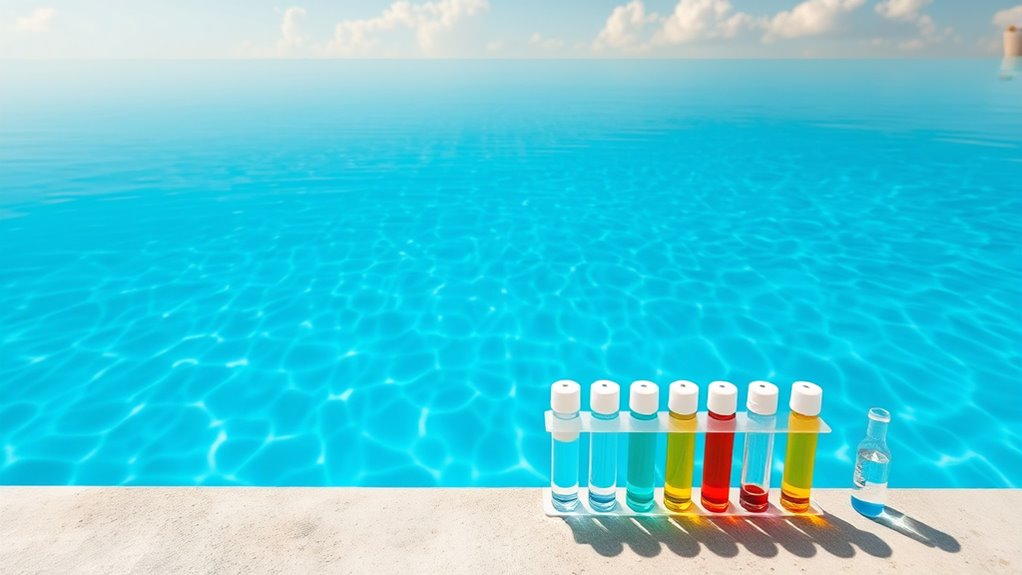
To keep your pool water balanced, you need to test it accurately and regularly. Choosing the right testing tools and sticking to a consistent schedule helps you catch issues early. Learning how to interpret your test results guarantees your pool stays clean and safe for swimming. Utilizing accurate testing methods ensures you can maintain optimal water quality and address problems promptly.
Proper Testing Tools Selection
Choosing the right testing tools is essential for accurately monitoring your pool’s water quality. You want reliable, easy-to-use kits that give quick results. Consider test strips for simplicity and affordability, liquid test kits for accuracy, or digital testers for precision. Each tool has its strengths depending on your needs. Using AI-powered testing solutions can further enhance the accuracy and efficiency of water quality assessments.
Regular Testing Schedule
Once you’ve selected the right testing tools, establishing a consistent testing schedule helps keep your pool water balanced. Aim to test your water at least two to three times a week, especially during peak usage or hot weather. Regular testing ensures you catch imbalances early before they become bigger problems. Develop a routine, such as testing every Monday, Wednesday, and Friday, so it becomes second nature. Keep a log of your test results to track trends over time. This consistency allows you to respond quickly with the appropriate chemicals when levels are off. Remember, frequent testing is key to maintaining clear, safe water and reducing the need for costly corrections later. Staying proactive with your testing schedule keeps your endless pool in top condition effortlessly. Additionally, understanding how pool chemistry affects water quality can help you make more informed adjustments.
Interpreting Test Results
Understanding how to interpret your pool test results is essential for maintaining balanced water. When you test, you’ll see numbers or color indicators that reveal your water’s condition. To make sense of these:
- Check the pH level; it should be between 7.2 and 7.6 for comfortable swimming.
- Look at the chlorine or sanitizer reading; it needs to be between 1 and 3 ppm.
- Examine total alkalinity; aim for 80-120 ppm to prevent pH swings.
- Review calcium hardness; keep it between 200-400 ppm to avoid scaling or corrosion.
- Consider modern shower fixtures; they can help reduce water consumption and improve pool water efficiency.
If readings fall outside these ranges, adjust your chemicals accordingly. Regularly interpreting results helps you balance your water and avoid problems down the line, ensuring a safe, crystal-clear pool.
Maintaining Proper Ph and Alkalinity Levels

Maintaining proper pH and alkalinity levels is essential for keeping your endless pool safe, clear, and comfortable to swim in. When your pH is too low, your water can become corrosive, damaging equipment and irritating your skin and eyes. If it’s too high, your water may become cloudy and scale buildup can occur. Alkalinity acts as a buffer, preventing rapid pH fluctuations. Aim for a pH between 7.4 and 7.6, and alkalinity around 80-120 ppm. Regular testing helps you track these levels, and adjustments are simple with pH increasers or decreasers and alkalinity balancers. Consistent maintenance ensures your water remains balanced, reducing the need for more extensive chemical treatments later. Staying on top of pH and alkalinity keeps your endless pool inviting and safe for every swim. Utilizing reliable testing kits and understanding the air quality benefits of balanced water can further enhance your swimming experience.
Chlorine and Sanitizers: Keeping Your Pool Safe

To keep your endless pool safe and hygienic, using the right amount of chlorine and other sanitizers is essential. Proper sanitization prevents bacteria, algae, and odors. Here’s what you should do:
Maintaining proper sanitizer levels keeps your endless pool safe, clear, and free from bacteria and odors.
- Test your water regularly to ensure chlorine levels stay between 1-3 ppm.
- Add chlorine tablets or liquid chlorine as needed, following manufacturer instructions.
- Use a sanitizer like bromine or alternative options if preferred.
- Shock the pool weekly to eliminate organic contaminants and maintain water clarity.
- Utilize testing apps or kits to accurately monitor sanitizer levels and ensure optimal water quality.
Always follow dosing guidelines carefully to avoid over-sanitizing, which can cause skin irritation or damage pool equipment. Keeping your sanitizer levels balanced guarantees safe, crystal-clear water and a healthier swimming environment.
Managing Calcium Hardness and Water Balance

Properly managing calcium hardness is essential to prevent scale buildup and corrosion in your endless pool. Too much calcium causes cloudy water and scale on surfaces, while too little leads to corrosion of equipment. Aim for a calcium hardness level between 150-250 ppm. To keep water balanced, regularly test your water and adjust as needed. Use calcium increasers or decreasers based on test results. Maintaining proper alkalinity and pH levels also supports water balance. Here’s a quick reference:
| Parameter | Ideal Range |
|---|---|
| Calcium Hardness | 150-250 ppm |
| pH | 7.4-7.6 |
| Total Alkalinity | 80-120 ppm |
| Water Balance | Maintain equilibrium |
| Regular Testing | Weekly |
Consistent monitoring keeps your pool crystal clear and equipment protected.
Troubleshooting Common Pool Water Problems

When pool water develops problems, quick identification and action can save you time and expense. First, test your water to pinpoint issues accurately. Then, follow these steps:
- Cloudy Water: Check chlorine levels and pH; adjust accordingly and run the filter longer.
- Green Water: Brush the pool, increase chlorine, and run the pump continuously to eliminate algae.
- Faded or Stained Water: Balance pH and alkalinity, then shock the pool to remove organic buildup.
- Strong Chlorine Odor: Ensure proper aeration, reduce chloramine levels by shocking, and maintain proper chlorine levels.
Frequently Asked Questions
How Often Should I Test My Pool Water?
You should test your pool water at least 2 to 3 times a week to maintain proper chemistry. If your pool gets heavy use or experiences weather changes, test more frequently. Use a reliable test kit to check pH, chlorine, and alkalinity levels. Regular testing helps you catch imbalances early, ensuring your water stays clear, safe, and comfortable for swimming.
What Are Signs of Chemical Imbalance in My Pool?
You might notice your pool water looks a bit off, like a hazy mirror or dull surface. If your water has an unusual smell, feels sticky, or causes your eyes to sting, these are signs of imbalance. Cloudy water, algae growth, or frequent chemical odors also suggest it’s time to check your chemicals. Staying attentive helps you maintain clear, healthy water and enjoy your pool without worries.
Can I Use Natural Products to Treat My Pool Water?
Yes, you can use natural products to treat your pool water, but proceed with caution. Natural options like mineral-based clarifiers or enzyme treatments can help maintain clarity without harsh chemicals. However, they may not be as effective in balancing pH or eliminating bacteria. Always test your water regularly, follow product instructions carefully, and consider consulting a pool professional to guarantee your water stays safe and clean.
How Does Weather Affect Pool Water Chemistry?
Weather considerably impacts your pool water chemistry, with over 70% of pool issues linked to environmental factors. When it’s hot and sunny, chlorine dissipates faster, risking algae growth, so you’ll need to maintain higher sanitizer levels. Rain dilutes chemicals and introduces debris, lowering water quality. Cold weather slows chemical reactions, requiring adjustments to keep your water balanced. Always monitor weather forecasts to optimize your pool maintenance routine effectively.
What Safety Precautions Should I Take When Handling Pool Chemicals?
You should always wear protective gear like gloves and goggles when handling pool chemicals to prevent skin and eye irritation. Work in a well-ventilated area to avoid inhaling fumes, and never mix chemicals—this can cause dangerous reactions. Follow the instructions carefully, add chemicals slowly, and store them in a secure, dry place away from children and pets. Always wash your hands afterward to stay safe.
Conclusion
With a little understanding and regular testing, you’ll turn your pool into a shimmering oasis, crystal-clear and inviting. Imagine stepping into water so pure it reflects the sky like a mirror, every ripple whispering of perfect balance. Keep the chemicals in check, and your pool will stay a tranquil sanctuary, ready for endless summer swims. Plunge in with confidence, knowing you hold the secret to flawless water all season long.
